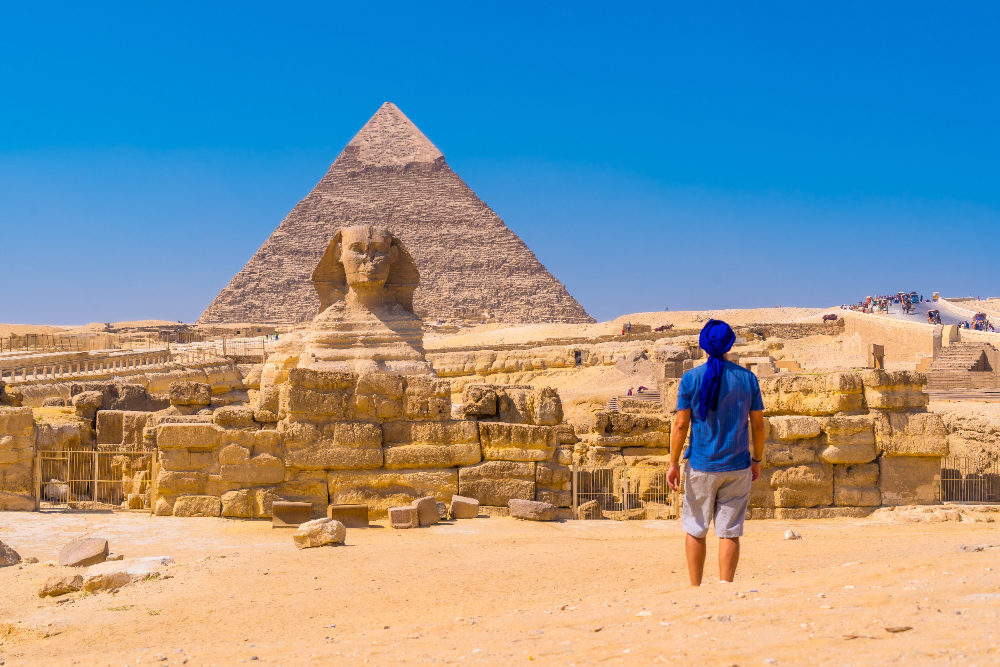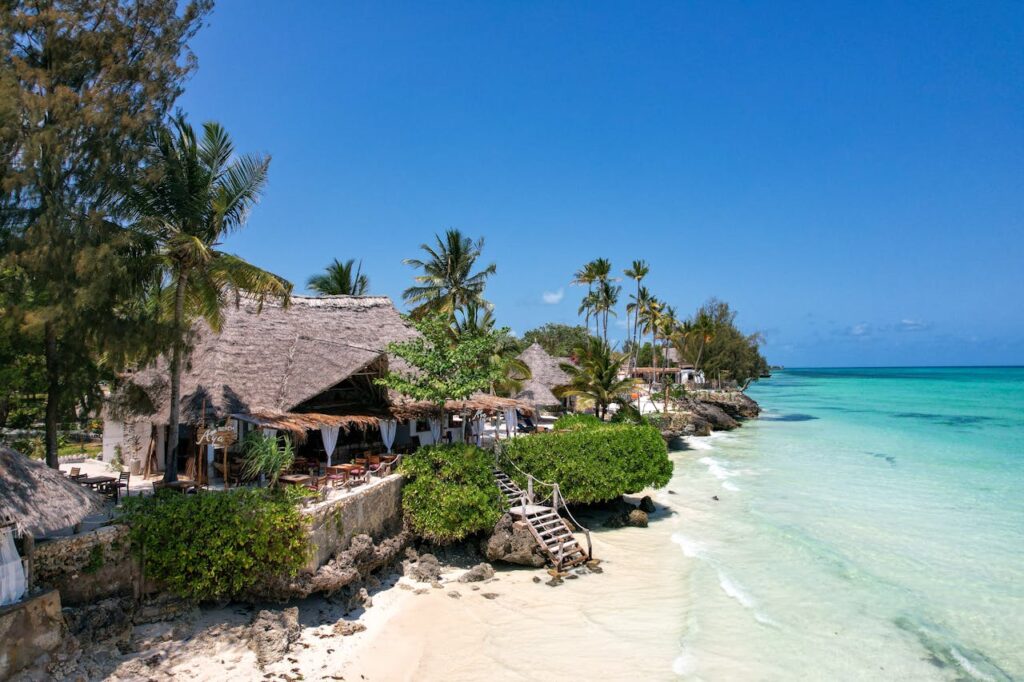Morocco is a land of breathtaking contrasts, where ancient medinas meet modern cities, snow-capped mountains border golden deserts, and Atlantic waves crash against Mediterranean shores. This North African kingdom offers some of the most spectacular landscapes and cultural treasures in the world. Here are the five most beautiful places that should be on every traveler’s Morocco itinerary.
1. Ouzoud falls – nature’s spectacular show
The magnificent Ouzoud falls stands as Morocco’s most impressive natural wonder, cascading 110 meters down red limestone cliffs in a series of three dramatic tiers. Located in the Atlas mountains, about 150 kilometers northeast of Marrakech, these waterfalls create one of the most breathtaking spectacles in North Africa.
What makes Ouzoud truly magical is the constant mist that rises from the thundering water, creating perfect conditions for rainbows that dance across the falls throughout the day. The surrounding landscape is equally stunning, with olive groves stretching as far as the eye can see and traditional Berber villages dotting the mountainsides.
The falls are at their most powerful during spring when the snowmelt from the High Atlas feeds the Ouzoud river. During this season, the water volume is tremendous, and the sound of cascading water can be heard from kilometers away. Summer brings a different beauty, with crystal-clear pools perfect for swimming and a more intimate atmosphere as the water levels recede slightly.
Wildlife enthusiasts will be delighted by the resident Barbary macaques that inhabit the area. These playful primates are often seen along the walking trails, particularly in the early morning hours. The surrounding ecosystem supports diverse flora and fauna, making it a paradise for nature photographers and botanists.
The hiking trails around Ouzoud offer varying levels of difficulty, from easy walks along the river to challenging climbs that reward visitors with panoramic views of the Atlas mountains. Traditional mills powered by the waterfall still operate, providing glimpses into centuries-old agricultural practices. For all the details about Ouzoud, including the best times to visit and practical tips, detailed guides are invaluable for planning your journey.
Local Berber guides offer authentic experiences, sharing stories about the region’s history and pointing out hidden viewpoints that most tourists never discover. The small restaurants perched on the cliffs serve fresh trout caught from the river and traditional tagines while offering spectacular views of the falls.
2. Sahara desert at Erg Chebbi – golden infinity
The Sahara desert represents the ultimate Moroccan adventure, and nowhere is it more spectacular than at Erg Chebbi near Merzouga. These towering sand dunes, some reaching heights of 150 meters, create an otherworldly landscape that changes color throughout the day, from pale gold at dawn to deep orange at sunset.
The silence of the desert is profound and almost spiritual. Standing atop a dune at sunrise, watching the first rays of light paint the endless sand in shades of rose and gold, creates memories that last a lifetime. The play of light and shadow across the undulating dunes creates an ever-changing canvas that photographers dream about.
Camel trekking remains the most authentic way to experience the Sahara. These gentle giants move rhythmically across the sand, their soft footsteps the only sound breaking the desert silence. Multi-day expeditions allow visitors to truly disconnect from modern life and experience the desert as nomads have for centuries.
The night sky in the Sahara is absolutely spectacular, with the Milky Way clearly visible and shooting stars frequent occurrences. Desert camps offer the perfect vantage point for stargazing, with traditional Berber tents providing comfort without compromising the authentic experience.
Desert wildlife, though sparse, is fascinating. Fennec foxes, sand cats, and various reptiles have adapted to this harsh environment in remarkable ways. The desert flora, including drought-resistant plants and occasional oases with date palms, demonstrates nature’s incredible resilience.
3. Chefchaouen – the blue pearl of Morocco
Nestled in the Rif mountains, Chefchaouen enchants visitors with its distinctive blue-washed buildings that create a dreamlike atmosphere unlike anywhere else in the world. This small mountain town, founded in 1471, has become one of Morocco’s most photographed destinations, and for good reason.
The tradition of painting buildings blue dates back centuries, with various theories explaining its origins. Some say it was introduced by Jewish refugees who settled here in the 1930s, as blue represents the sky and heaven in Jewish culture. Others believe it helps repel insects or keeps buildings cool in the mountain climate.
Wandering through Chefchaouen’s narrow cobblestone streets feels like stepping into a fairy tale. Every corner reveals new shades of blue, from powder blue to deep indigo, creating an Instagram-worthy backdrop at every turn. The medina’s small scale makes it perfect for leisurely exploration without the overwhelming crowds found in larger cities.
The surrounding Rif mountains offer excellent hiking opportunities with trails leading to waterfalls, traditional villages, and viewpoints overlooking the town. The contrast between the blue medina and the green mountains creates stunning photographic opportunities.
Local artisans specialize in beautiful wool garments, particularly the distinctive striped blankets and clothing that characterize the region. The markets offer high-quality crafts at reasonable prices, and the relaxed atmosphere makes shopping a pleasure rather than a hassle.
4. Marrakech – the red city’s timeless magic
Marrakech captivates visitors with its intoxicating blend of ancient tradition and modern sophistication. The medina, a UNESCO world heritage site, pulses with life as it has for nearly a thousand years, while the new city showcases contemporary Morocco at its finest.
| Best time to visit | Activities | Must-see attractions | Local specialties |
|---|---|---|---|
| October to April | Medina exploration, garden visits | Jemaa el-Fnaa, Bahia palace | Tagines, mint tea |
| Cooler weather | Palace tours, souk shopping | Koutoubia mosque, Majorelle garden | Pastries, leather goods |
| Clear skies | Traditional hammams | Saadian tombs, Ben Youssef | Spices, carpets |
The iconic Jemaa el-Fnaa square transforms throughout the day, starting as a quiet plaza at dawn and evolving into one of the world’s greatest spectacles by nightfall. Snake charmers, storytellers, musicians, and food vendors create a sensory overload that epitomizes the Moroccan experience.
The architectural treasures of Marrakech are unparalleled. The Koutoubia mosque’s minaret dominates the skyline, while the Bahia palace showcases the finest examples of Islamic art and architecture. The Saadian tombs, hidden for centuries, reveal the opulent burial chambers of Morocco’s greatest dynasty.
The souks of Marrakech are legendary, with their maze-like passages hiding treasures from across Africa and beyond. Skilled artisans work in tiny workshops, creating everything from leather goods to intricate metalwork using techniques passed down through generations.
Modern Marrakech offers world-class restaurants, luxury riads, and contemporary art galleries that attract international visitors seeking sophistication alongside authenticity. The Majorelle garden, once owned by Yves Saint Laurent, provides a peaceful escape with its vibrant blue buildings and exotic plant collections.
5. Essaouira – where ocean meets history
Essaouira offers a perfect blend of Atlantic coastal beauty and rich historical heritage. This fortified port city, with its Portuguese-influenced architecture and bohemian atmosphere, provides a refreshing contrast to Morocco’s inland destinations.
The medina’s whitewashed buildings and blue shutters create a Mediterranean feel, while the massive stone ramparts facing the ocean speak to centuries of strategic importance. The UNESCO-listed old town is remarkably well-preserved, with its grid-like street layout making navigation easy and enjoyable.
The port remains active, with blue fishing boats bringing in daily catches that appear fresh on restaurant tables within hours. Watching the fishermen mend their nets while seagulls circle overhead provides authentic glimpses into traditional coastal life.
Essaouira’s beaches stretch for miles, offering excellent conditions for windsurfing and kitesurfing. The consistent trade winds that once brought merchants from around the world now attract water sports enthusiasts seeking perfect conditions.
The city’s artistic heritage is remarkable, with numerous galleries showcasing local and international artists. The annual Gnawa world music festival transforms Essaouira into Morocco’s cultural capital, attracting musicians and music lovers from around the globe.
Travel planning essentials
| Destination | Distance from Casablanca | Best season | Typical stay duration | Budget level |
|---|---|---|---|---|
| Ouzoud falls | 280 km (3.5 hours) | March to May | 1-2 days | Budget-friendly |
| Sahara (Merzouga) | 560 km (7 hours) | October to April | 2-3 days | Mid-range |
| Chefchaouen | 340 km (4 hours) | April to October | 2-3 days | Budget-friendly |
| Marrakech | 240 km (2.5 hours) | Year-round | 3-5 days | All budgets |
| Essaouira | 350 km (3.5 hours) | Year-round | 2-4 days | Mid-range |
Each of these destinations offers unique experiences that showcase different aspects of Morocco’s incredible diversity. From the natural splendor of Ouzoud falls to the cultural richness of Marrakech, from the desert vastness of the Sahara to the coastal charm of Essaouira and the mountain serenity of Chefchaouen, Morocco provides a lifetime of discoveries.
The best time to visit varies by region, with spring and autumn generally offering the most comfortable weather across the country. Summer can be intense in the desert and inland cities, while winter brings snow to the mountains and mild temperatures to the coast.
Whether you’re seeking adventure, culture, relaxation, or spiritual renewal, Morocco’s most beautiful places deliver experiences that exceed expectations and create memories that last forever. Each destination tells part of Morocco’s fascinating story, from ancient Berber traditions to Islamic architecture, from colonial influences to modern aspirations.
For travelers interested in exploring more of North Africa’s stunning desert landscapes, the neighboring country of Algeria offers equally spectacular destinations, such as the enchanting oases of Taghit where traditional architecture meets endless dunes in a setting that rivals any Saharan experience.




